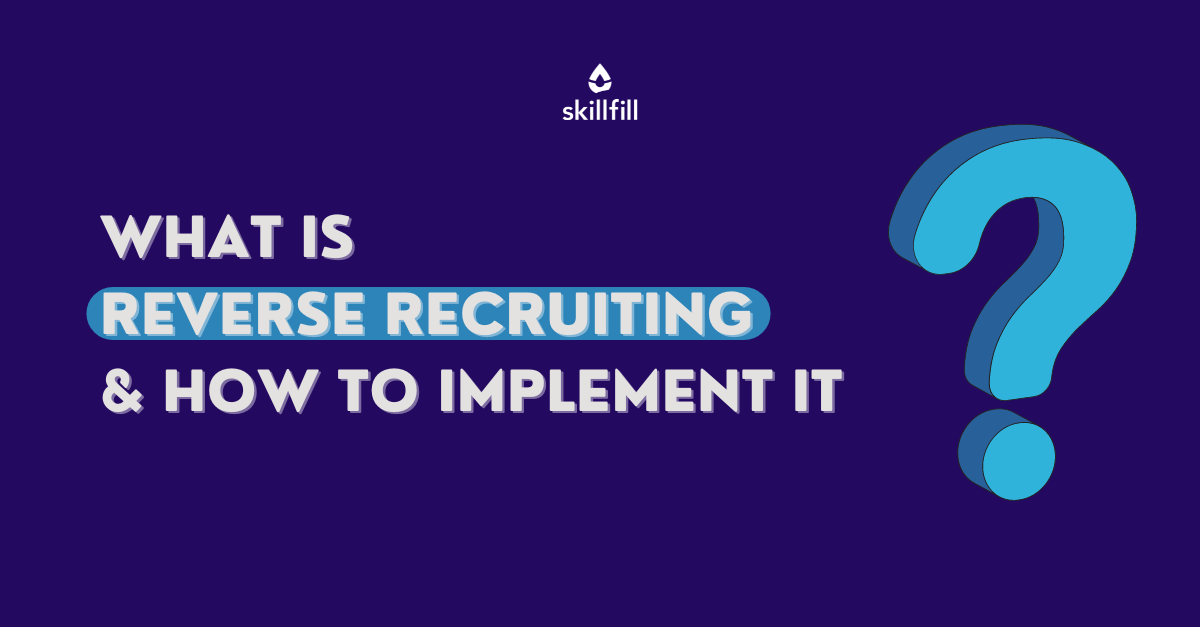Assuming Outside the Box: Reverse Recruiting Methods for Success
Assuming Outside the Box: Reverse Recruiting Methods for Success
Blog Article
Unlock the Power of Reverse Hiring Strategies for Successful Talent Purchase
By luring leading skill to seek out chances within your organization, reverse recruiting offers a fresh strategy to attracting and retaining key workers. As companies strive to stay in advance in the skill video game, opening the possibility of reverse recruiting methods might be the trick to protecting a solid and vibrant workforce.
Recognizing Reverse Hiring
Recognizing reverse recruiting is pivotal in browsing the progressing landscape of ability procurement approaches. Unlike standard employment methods where companies choose candidates, reverse recruiting includes the proactive method of candidates choosing potential companies. This paradigm change puts prospects in the driver's seat, permitting them to choose companies that align with their values, profession goals, and work choices.
Basically, reverse recruiting encourages prospects to take control of their work search process by researching business, connecting to recruiters or employing supervisors straight, and showcasing their skills and experiences. For companies, this approach offers a distinct opportunity to bring in leading talent that are genuinely thinking about the company and its objective, cultivating an extra involved and committed workforce.
Benefits of Reverse Recruiting
Utilizing reverse recruiting approaches can yield considerable advantages for both prospects and employers in the ability procurement process. For prospects, among the main benefits is the capability to have more control and transparency in the job search. By being come close to by employers that have actually currently determined them as prospective suitable for their company, prospects can feel more valued and looked for after. reverse recruiting. This can bring about increased job complete satisfaction and a higher probability of approving a deal from a company that proactively sought them out.
On the various other hand, employers can profit from reverse recruiting by accessing to a pool of easy prospects who might not be actively looking for new chances. This permits companies to target people with certain skill collections or experiences that line up with their requirements, possibly leading to better works with. In addition, reverse recruiting can assist business differentiate themselves in an affordable skill market by showcasing an aggressive and forward-thinking approach to recruitment. Inevitably, the benefits of reverse recruiting reach both prospects and companies by streamlining the working with process and cultivating even more meaningful connections between the two parties.

Carrying Out Reverse Recruiting Techniques
To efficiently incorporate reverse recruiting methods into a talent acquisition approach, organizations must prioritize aggressive involvement with potential candidates. By showcasing the firm culture, values, and job advancement possibilities, companies can pique the interest of prospective candidates and construct a skill pipe for future needs.
Moreover, executing customized interaction methods can additionally improve the performance of reverse recruiting. By regularly supporting relationships with leading talent, companies can stay ahead in the competitive ability purchase landscape and protect the best candidates for their team - reverse recruiting.
Leveraging Technology in Reverse Recruiting
In the electronic age of ability procurement, taking advantage of technological improvements is critical for effective execution of reverse recruiting techniques. Leveraging technology in reverse recruiting offers countless advantages to streamline the procedure and attract leading ability properly. Candidate radar (ATS) play a critical role in handling candidate information, tracking interactions, and automating interaction, permitting recruiters to concentrate on building connections with prospective hires.
Using information analytics devices can aid employers measure the performance of their reverse recruiting methods, identify locations for improvement, and make data-driven decisions to enhance the skill purchase procedure - this link reverse recruiting. By embracing technology in reverse recruiting, organizations can remain in advance in the affordable ability market and safe and secure top talent efficiently.
Measuring Success in Reverse Hiring
Having actually established the foundational function of innovation in optimizing reverse recruiting strategies, the next critical step exists he said in effectively gauging the success of these ingenious strategies. In the world of reverse recruiting, traditional metrics like time-to-fill and cost-per-hire may not fully record the effect of these approaches. Instead, determining success in reverse recruiting requires a more nuanced technique that concentrates on candidate engagement, company branding enhancement, and long-term skill retention.
One secret metric to take into consideration is prospect experience. By gathering responses from candidates that have actually undergone the reverse recruiting process, companies can get important understandings right into areas for enhancement and identify strengths to leverage. In addition, tracking metrics connected to employer brand assumption, such as social media sentiment and Glassdoor testimonials, can give a much more holistic sight of exactly how reverse recruiting is shaping the organization's online reputation in the ability market.
Ultimately, success backwards recruiting should be gauged not just by the performance of loading roles but additionally by the high quality of hires, their placement with business culture, useful content and their long-term efficiency within the business. By adopting a comprehensive technique to gauging success, companies can absolutely unlock the potential of reverse recruiting approaches for effective ability procurement.
Final Thought

Report this page